Are you ready to take off?
Welcome to our series on studying abroad in Japan!
Today, I’ll cover everything you need for a smooth arrival: what to prepare before boarding the plane, the forms you need to fill out during the flight, and what to do when you arrive at the airport in Japan. Let’s get started!
- For preparation in your home country, check (Part 1) Before Leaving: What Should I Pack and Prepare?
- Planning your arrival at Haneda Airport? Check Your Complete Guide to Haneda Airport.

Hello readers! Sakura Mobile is a SIM WiFi service provider for international residents and tourists in Japan.
Our global editorial team living in Japan will introduce the charms of the country based on what we have actually experienced and felt.
Table of Contents
Before Your Flight
During Your Flight (Without Visit Japan Web)
Airport: Immigration Inspection
Airport: Arrival
Before your flight
0. Register Visit Japan Web
What is Visit Japan?
Before boarding, registering for Visit Japan Web is recommended. Fortunately, as of April 2024, complicated paperwork or quarantine procedures due to COVID-19 are almost gone. However, paperwork for the immigration process is still one of the reasons that cause delays at the airport. Thus, I recommend you sign up for Visit Japan Web in advance. It’s not obligatory; you can still complete the process through paperwork. However, registering for Visit Japan Web would speed up your immigration and customs.
Visit Japan Web consists of 3 parts – 1) Immigration information, 2) Customs information, and 3) Tax-exemption section.
You’ll receive 3 QR codes after you complete the three sections. For international students, you will only need the first two QR codes to show at the airport upon arrival. The third one is for tax-free shopping for tourists.
Tip: Screenshot/print your QR code
In case you have internet problems or phone battery issues, we recommend taking a screenshot or printing out your QR code so you have a backup just in case anything happens.
Did you check your necessary luggage and register to Visit Japan Web? Now, let’s get on board!

Fill out two forms on the airplane: “Disembarkation Card for Foreigner (外国人入国記録)” and “Customs Declaration Form (Full name: Declaration of Personal Effects and Unaccompanied Articles, 携帯品・別送品申告書)”.
↑ Go back to the table of contents
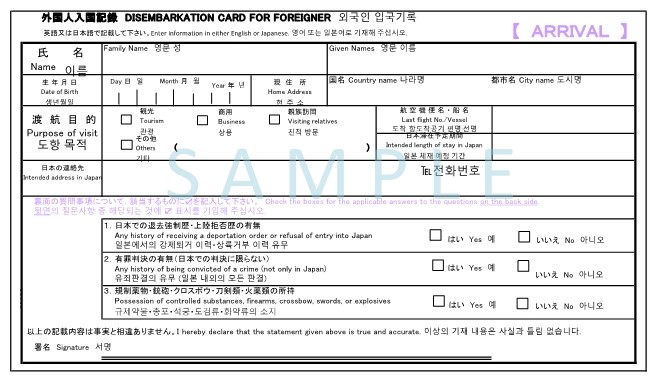
★For “Purpose of visit”
-Long-term study (With Student Visa): Check “others” and write “Study” or “留学”
-Short-term study (Without Student Visa, Less than 90 days): Check “others” and write “Short-term study” or “短期留学”
★For “Intended address in Japan”
-Write your Japan home address either in English or Japanese (Kanji)
-If you don’t have a home address or a phone number yet, you can write your school’s address and phone number
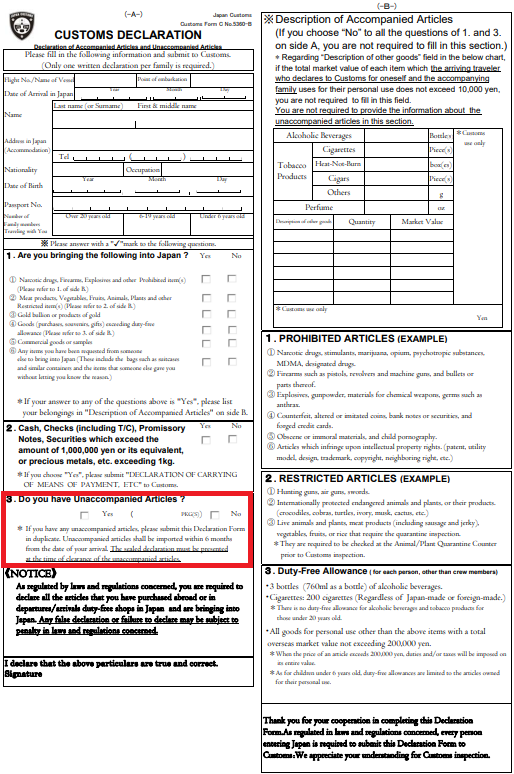
★ For 3. Do you have Unaccompanied Articles? (Red box in the above image)
-Check “yes” and write the number of parcels only if you have sent a parcel through EMS or an international parcel from your home country.
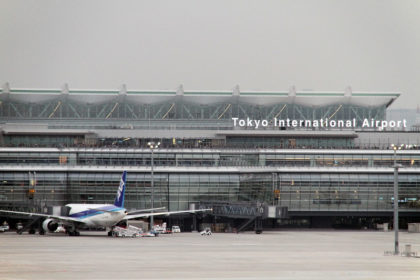 Welcome to Japan!
Welcome to Japan!
Immigration Inspection (Submit Disembarkation Card for Foreigner, passport, COE, student visa, and work permit form to receive a Residence Card with work permit stamp)
↓
Baggage Claim
↓
Customs Inspection (Submit Customs Declaration Form)
↓
Arrival Lobby (Pick up SIM card or Pocket Wi-Fi if needed)
↑ Go back to the table of contents
At the Immigration Inspection
1. Receive Residence Card
What is a Residence Card?
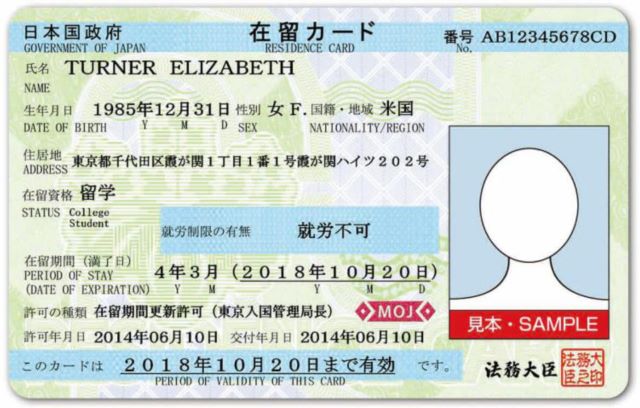
A Residence Card is issued to residents staying in Japan for over three months with a valid mid-to-long-term visa. It shows your identification information, period of stay, your status of residence etc. You need to carry your residence card at all times, as it can be used as an ID for official procedures. If you are a long-term student, you’ll have to renew your Residence Card at the “Immigration Services Agency of Japan (出入国在留管理庁)” later on in your stay. You can apply for the renewal three months before the date of expiration.
When/Where to Receive a Residence Card
• Narita, Haneda, Kansai, Chubu, New Chitose, Hiroshima, Fukuoka Airport
: You will receive your Residence Card at the immigration inspections. Once you present your passport, COE, student visa (all are likely attached to your passport), and possibly the admission letter from your enrolled school, the officials will print out the card right there.
• Other Airports
: You will NOT receive your Residence Card at the immigration inspections. You will receive a seal confirming the landing verification, along with a note, “Residence Card will be issued at a later date.” Your Residence Card will be issued after you follow the residency procedure at the municipal office of your city/ward/town. You should complete the residency procedure within two weeks after arrival. (We recommend completing this as soon as you arrive in your new city/town/ward!)
↑ Go back to the table of contents
2. Apply for Work Permit
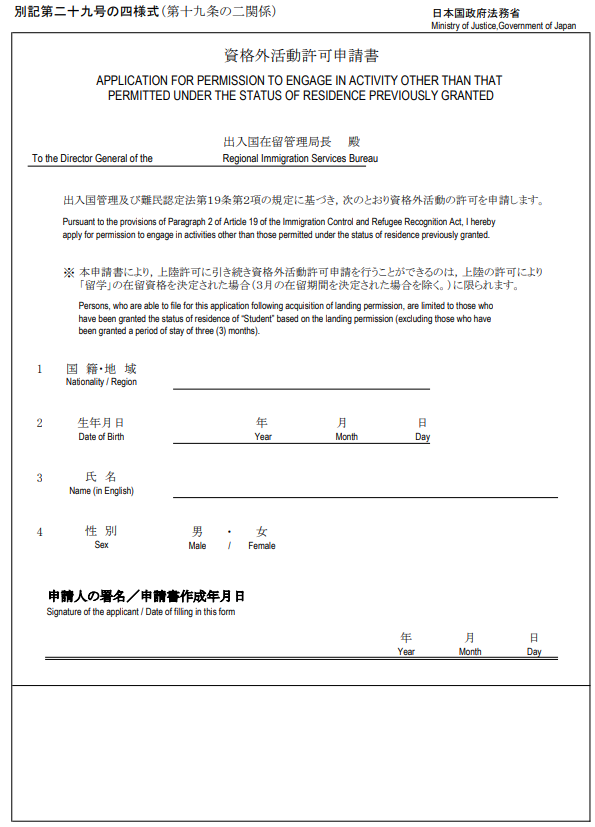
This is the part I neglected and caused me an extra two weeks to obtain permission for a part-time job. In principle, a student visa does not allow one to work in Japan as a foreigner. If you wish to get a part-time job or an internship, you must apply for a “work permit.”
With the work permit, you can work up to 28 hours per week during the school semester and 40 hours per week, 8 hours per day during the summer/winter/spring breaks. Jobs related to the sex industry, such as hostess bars/clubs, love hotels, adult goods or video stores, massage parlors, or video game arcades, are restricted.
Even if you don’t imagine yourself working part-time in Japan, I highly recommend completing this process. You never know! You also need to renew the work permit as you renew your period of stay. If you forget to, you’ll apparently be working illegally without realizing it.
How to Apply for Work Permit
It’s simple. When submitting the document to create the residence card at the immigration inspection, submit the filled-out “Permit to Engage in Activity Other than that Permitted by the Status of Residence Previously Granted” application form together. You can download it from here.
Go under [申請書・必要書類・部数] and download either 資格外活動許可申請書, which is a basic form, or 資格外活動許可申請書(留学生が新規入国する場合)which is for newly entering international students. Your school might send you the form or have information about the work permit on their websites.
If you forgot to write it beforehand, ask the inspector for one. When you receive your residence card, there will be a stamp on the bottom of the back, like the following image.
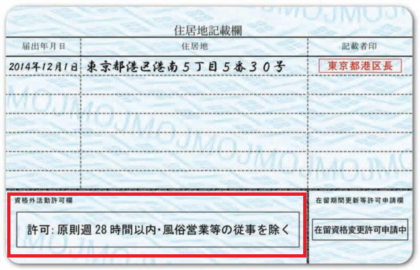
↑ Go back to the table of contents
At the Arrival
3. Pick up your SIM

If you reserved a mobile SIM card in advance and decided to pick it up at the airport, head to the carrier counters at the arrival lobby. Make sure to check the locations and operating hours.
Sakura Mobile provides pick-up service at six airports: Narita, Haneda, Kansai, Chubu, New Chitose, and Naha airport. Check here for Sakura Mobile’s airport counter locations!
In case you need immediate internet access for multiple devices after arrival, Sakura Mobile also provides short-term and long-term pocket Wi-Fi. Make a reservation online at least 3 days before your pickup date and pick up right away at the airport. After arriving in Japan, you’ll need to search the internet for information about official procedures, etc. A stable internet connection through pocket Wi-Fi, in addition to a SIM card, can eliminate the fear of running out of internet access.
Related Articles:
Your Complete Guide to Narita Airport
Your Complete Guide to Haneda Airport (HND)
Kansai Airport Guide: Start Your Japan Journey on the Right Foot
↑ Go back to the table of contents
Conclusion
When I first entered Japan, I recall being overwhelmed by the Japanese language, heavy luggage, anxiety about losing documents, etc. (especially with the complex quarantine procedures back in 2022…) After reading this article, I hope you have a safe and smooth flight to Japan. Congratulations on your first step to Japan!
Before you go off and enjoy life in Japan, are you aware of the necessary procedures you need to accomplish ASAP after arriving? From address registration to applying for student health insurance, it can be tricky if you’re unfamiliar with Japanese terminology.
Moreover, these procedures need to be done in a specific order you need to follow, or else you might end up either
1. Going to the ward office multiple times and waiting in an endless waiting line
2. Receiving a warning filled with incomprehensible Japanese via post mail and panic about what you have missed and asking every person you know what to do about it
To be aware of the process and simplify things, bookmark our blog page and stay tuned for our next article, “(Part 3) After Arrival: 4 Important Procedures.”
Of course, more about setting up life in Japan is coming soon! So stay tuned to our Study Abroad Series for more information about studying in Japan!
(Part 1) Before Leaving: What should I pack and prepare?
(Part 3) After Arrival: 4 Important Procedures to Get Done Right Away
↑ Go back to the table of contents
CUSTOMER’S VOICE


